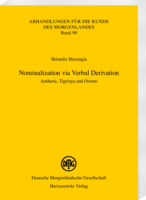|
|
more titles of the subject:
Download:
Please note: With adding digital Products to your cart
the payment will be handled via PayPal. The download will be provided after the payment is confirmed. All languages are in a state of flux, and the viable ones employ various devices to introduce new words into their vocabularies. In the formation of new words and other expressions, noun formation or nominalization has pride of place over the other word-classes. Shimelis Mazengia describes and contrastively compares, in considerable detail, the mechanisms which three major Ethiopian languages use to satisfy their needs for nominals at word, phrasal and clausal levels – in other words, the operations utilized for lexical, phrasal, and clausal nominalizations. The languages in question are the Semitic languages Amharic and Tigrinya, and the Cushitic language Oromo. However, Amharic is sometimes considered to have undergone significant Cushitic influence and is therefore often assumed to be structurally intermediate between Semitic and Cushitic. The description and analyses take tone into account for Oromo, as tone is considered to have some bearing on the nominalization processes of the language.
The author is a native speaker of Amharic and Oromo and is also well acquainted with Tigrinya. His competence in the languages has helped him to insightfully deal with the description and analysis of the languages with a wealth of data. |
|||||||||||||||||||||||||||||||||||||||||






